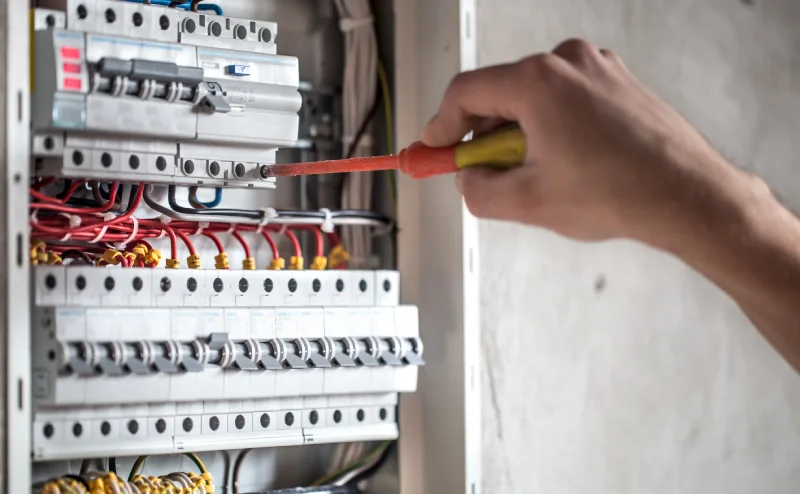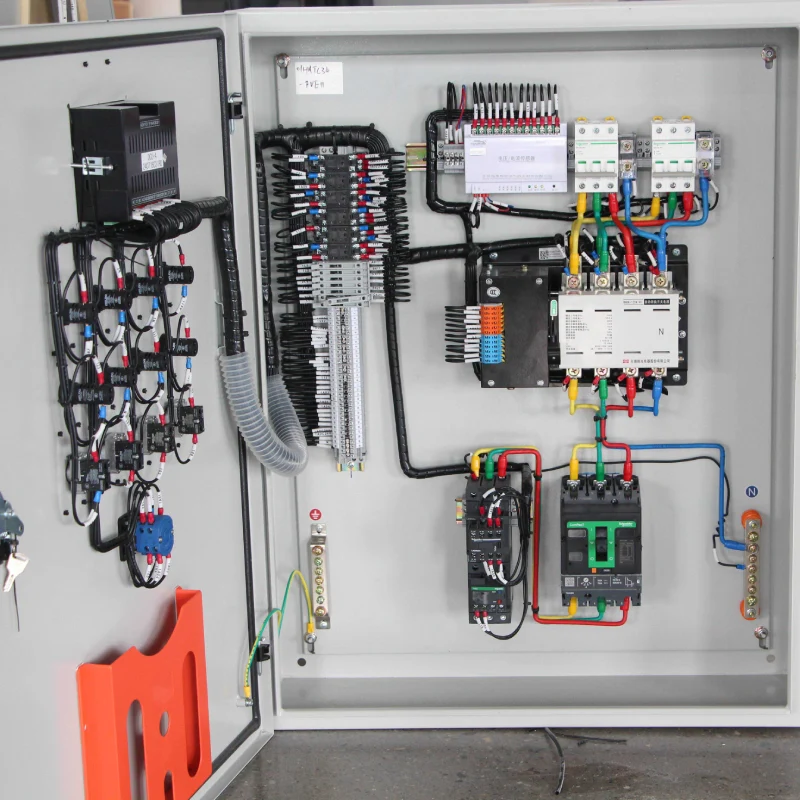A consumer unit is the main electrical distribution point in your home that controls and protects all electrical circuits through circuit breakers and safety devices. Also known as a fuse box, electrical panel, or distribution board, the consumer unit is your property’s electrical control center that ensures safe power distribution throughout your home.
Quick Answer: Consumer Unit Essentials
Consumer units distribute electricity from the main supply to individual circuits in your home while providing essential safety protection through:
- ເຄື່ອງຕັດວົງຈອນ that prevent electrical overloads
- RCD (Residual Current Device) protection against electric shocks
- Isolation switches for safe electrical work
- ການປ້ອງກັນໄຟຟ້າ for sensitive electronics
What Is a Consumer Unit? Technical Definition
A consumer unit is an electrical distribution board that receives power from your electricity supplier’s meter and safely distributes it to individual circuits throughout your property. Modern consumer units contain circuit breakers, RCDs, and other protective devices that automatically disconnect power during electrical faults, preventing fires, electric shocks, and equipment damage.
Key Components of Every Consumer Unit:
- Main switch: Isolates entire electrical installation
- ເຄື່ອງຕັດວົງຈອນ: Protect individual circuits from overload
- RCD protection: Prevents fatal electric shocks
- Busbar ລະບົບ: Distributes power to all circuits
- Neutral and earth bars: Provide safe electrical connections
Types of Consumer Units: Complete Comparison
Here is a table that shows the main types of consumer units and their key characteristics:
| Consumer Unit Type | ລະດັບການປົກປ້ອງ | ການນໍາໃຊ້ປົກກະຕິ | Circuit Capacity | ຄ່າໃຊ້ຈ່າຍໃນລະດັບ | ຄວາມສັບສົນໃນການຕິດຕັ້ງ |
|---|---|---|---|---|---|
| Standard Split Load | RCD protection for some circuits | Older homes | 6-12 circuits | £80-150 | ປານກາງ |
| High Integrity | Dual RCD protection | Modern homes | 10-16 circuits | £120-200 | ປານກາງ |
| RCBO Consumer Unit | ການປ້ອງກັນວົງຈອນສ່ວນບຸກຄົນ | New builds/upgrades | 12-20 circuits | £200-400 | Advanced |
| SPD Consumer Unit | Surge protection included | High-tech homes | 12-18 circuits | £250-450 | Advanced |
| Three-Phase Unit | Commercial-grade protection | Large properties | 20+ circuits | £300-600 | Professional only |
Standard Split Load Consumer Units
Standard split load consumer units divide circuits between RCD-protected and non-RCD sections. These units provide basic electrical safety but don’t meet current 18th Edition wiring regulations for new installations.
ດີທີ່ສຸດສຳລັບ: Older properties requiring basic upgrades
ຂໍ້ຈຳກັດ: Limited RCD coverage, potential for multiple circuit failures
High Integrity Consumer Units
High integrity units feature dual RCD protection, ensuring that if one RCD fails, the other continues protecting remaining circuits. This design minimizes the risk of total power loss.
ດີທີ່ສຸດສຳລັບ: Family homes requiring reliable power supply
ຂໍ້ດີ: Reduced inconvenience from RCD trips, improved safety
RCBO Consumer Units
RCBO (Residual Current Breaker with Overcurrent protection) consumer units provide individual protection for each circuit. Each RCBO combines circuit breaker and RCD functions in a single device.
ດີທີ່ສຸດສຳລັບ: New installations and comprehensive upgrades
ຂໍ້ດີ: Individual circuit isolation, maximum safety, easier fault-finding
How Consumer Units Work: Step-by-Step Process
Here’s how your consumer unit protects your home’s electrical system:
- Power Entry: Electricity enters through the main switch from your supplier’s meter
- Distribution: The busbar system distributes power to individual circuit breakers
- Circuit Protection: Each circuit breaker monitors current flow to specific areas
- Fault Detection: RCDs continuously monitor for earth leakage currents
- Automatic Disconnection: Protective devices trip instantly during electrical faults
- Safe Isolation: Main switch allows complete power disconnection for maintenance
⚠️ Safety Warning: Professional Installation Required
Consumer unit installation and replacement must be carried out by qualified electricians and certified under Building Regulations Part P. DIY electrical work on consumer units is illegal and extremely dangerous.
Consumer Unit Components Explained
Circuit Breakers vs. Fuses
| ຄຸນສົມບັດ | ຕົວຕັດວົງຈອນ | Traditional Fuses |
|---|---|---|
| ຣີເຊັດວິທີການ | Switch reset | Wire replacement required |
| Response Speed | Instant trip | Slower response |
| ລະດັບຄວາມປອດໄພ | ສູງກວ່າ | ພື້ນຖານ |
| ບໍາລຸງຮັກສາ | ໜ້ອຍທີ່ສຸດ | Regular replacement |
| ຄ່າໃຊ້ຈ່າຍ | ເບື້ອງຕົ້ນສູງກວ່າ | Lower initial |
| ການປະຕິບັດຕາມ | Meets modern standards | Outdated for new work |
RCD Protection Levels
30mA RCDs: Standard protection for socket outlets and lighting circuits
100mA RCDs: Fire protection for larger appliances and heating systems
300mA RCDs: Commercial applications requiring discrimination
When Do You Need a New Consumer Unit?
Mandatory Replacement Scenarios
You must replace your consumer unit if:
- Fuse box contains rewirable fuses (not compliant with current regulations)
- No RCD protection exists for socket circuits
- Unit shows signs of overheating, burning, or damage
- Electrical work requires Building Regulations approval
- Insurance requirements mandate modern protection
ຄໍາແນະນໍາຜູ້ຊ່ຽວຊານ: Signs Your Consumer Unit Needs Upgrading
- Frequent fuse blowing or circuit breaker trips
- Burning smells or scorch marks around the unit
- Crackling sounds from electrical connections
- ໄຟຫຼຸດແສງລົງເມື່ອເຄື່ອງໃຊ້ເລີ່ມຕົ້ນ
- Lack of adequate circuit capacity for modern electrical loads
Consumer Unit Installation Requirements
Building Regulations Compliance
All consumer unit work must comply with:
- Building Regulations Part P (England & Wales)
- BS 7671 18th Edition Wiring Regulations
- Local authority notification requirements
- Electrical Installation Certificate provision
Installation Location Standards
| ຄວາມຕ້ອງການ | ຂໍ້ມູນຈໍາເພາະ | Reason |
|---|---|---|
| ຄວາມສູງ | 1.2m – 2m from floor | Accessibility and safety |
| ການເຂົ້າເຖິງ | 600mm clear space in front | Maintenance access |
| ສະພາບແວດລ້ອມ | Dry, ventilated location | Prevent moisture damage |
| ສະຫນັບສະຫນູນ | Solid wall mounting | Structural stability |
| ການຕິດສະຫຼາກ | Clear circuit identification | Emergency isolation |
Consumer Unit Selection Guide
Choosing the Right Consumer Unit Size
Calculate your circuit requirements:
- Count existing circuits: Lighting, sockets, cooker, shower, etc.
- Plan future additions: Garden circuits, EV charging, home office
- Add 25% spare capacity: Accommodate unexpected needs
- Consider appliance demands: High-power equipment requirements
Expert Recommendation: Future-Proofing Your Installation
Choose RCBO consumer units for new installations. While initial costs are higher, they provide superior protection, easier fault-finding, and comply with latest safety standards.
Consumer Unit Safety and Maintenance
Monthly Safety Checks
Test your RCD protection monthly:
- Press the TEST button on each RCD
- Power should disconnect immediately
- Reset the RCD switch to restore power
- Contact an electrician if RCD fails to trip
⚠️ Critical Safety Warning
Never attempt to repair, modify, or work inside your consumer unit. All electrical work must be performed by qualified electricians holding appropriate certifications.
ຕາຕະລາງການບໍາລຸງຮັກສາເປັນມືອາຊີບ
| Inspection Type | ຄວາມຖີ່ | ຄວາມຕ້ອງການ |
|---|---|---|
| Visual Check | ປະຈໍາເດືອນ | RCD testing, loose connections |
| ການທົດສອບໄຟຟ້າ | 10 years (homes) | Full installation testing |
| Commercial Testing | 5 years | Comprehensive safety inspection |
| Rental Properties | 5 years | Mandatory EICR certificate |
Troubleshooting Common Consumer Unit Problems
Circuit Breaker Keeps Tripping
Possible causes and solutions:
- Overloaded circuit: Reduce appliances on affected circuit
- Faulty appliance: Disconnect devices individually to identify problem
- Damaged wiring: Contact electrician for circuit testing
- Incorrect breaker rating: Professional assessment required
RCD Trips Frequently
Investigation steps:
- Identify affected circuits: Note which RCD is tripping
- ກວດສອບຄວາມຊຸ່ມ: Inspect outdoor sockets and garden equipment
- Test appliances: Unplug devices and reset RCD
- Professional diagnosis: Persistent problems require electrical testing
Consumer Unit Costs and Installation
Price Breakdown by Type
| Consumer Unit Type | ຄ່າໃຊ້ຈ່າຍຕໍ່ຫນ່ວຍ | ຄ່າໃຊ້ຈ່າຍໃນການຕິດຕັ້ງ | ການລົງທຶນທັງໝົດ |
|---|---|---|---|
| Basic Split Load | £80-150 | £300-500 | £380-650 |
| High Integrity | £120-200 | £400-600 | £520-800 |
| RCBO Unit | £200-400 | £500-800 | £700-1200 |
| SPD Protected | £250-450 | £600-900 | £850-1350 |
Additional Installation Costs
Factor in these potential extras:
- ການທົດສອບໄຟຟ້າ: £150-300
- Building control notification: £150-200
- Remedial work: Variable depending on existing installation
- ການຢັ້ງຢືນ: Included with professional installation
Legal Requirements and Regulations
Building Regulations Part P
Consumer unit replacement requires:
- Qualified electrician installation
- Building control notification (or competent person scheme)
- Electrical Installation Certificate
- Compliance with BS 7671 standards
ຄໍາແນະນໍາຜູ້ຊ່ຽວຊານ: Choosing Qualified Electricians
Always use electricians registered with approved schemes (NICEIC, NAPIT, ELECSA) who can self-certify work under Building Regulations Part P.
ຖາມເລື້ອຍໆ
What’s the difference between a consumer unit and a fuse box?
A consumer unit is the modern term for what was traditionally called a fuse box. Modern consumer units use circuit breakers and RCDs instead of traditional fuses, providing better protection and easier reset capability.
How long do consumer units last?
Consumer units typically last 20-30 years, but should be replaced sooner if they don’t meet current safety standards or show signs of wear. Units with traditional fuses should be upgraded immediately.
Can I replace my own consumer unit?
No. Consumer unit replacement is notifiable work under Building Regulations Part P and must be performed by qualified electricians. DIY installation is illegal and dangerous.
What happens if my RCD keeps tripping?
Frequent RCD tripping indicates an electrical fault that could be dangerous. Turn off all appliances, reset the RCD once, and contact a qualified electrician if the problem persists.
Do I need surge protection in my consumer unit?
Surge protection is increasingly recommended for homes with sensitive electronics, electric vehicle charging, or solar panels. SPD-protected consumer units prevent damage from voltage spikes.
How do I know if my consumer unit is safe?
Safe consumer units have RCD protection, proper labeling, no signs of overheating, and pass regular testing. If your unit has traditional fuses or is over 30 years old, arrange a professional inspection.
Next Steps: Professional Consumer Unit Services
Ready to upgrade your electrical safety? Contact certified electricians for:
- Free safety assessments of your current installation
- Detailed quotations for consumer unit replacement
- Building Regulations compliance guidance
- Electrical Installation Certificates for insurance and legal requirements
Your consumer unit is your home’s electrical safety foundation. Invest in professional installation and regular maintenance to protect your property and family from electrical hazards.





